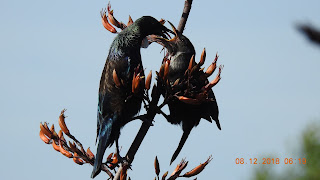 |
Parent feeding a young Tui. Mangaiti Gully.
Photo by Owen Cole |
We have spent a lot of time down in the gully over the last
eight years. Over this time we get a very good feeling on what the fauna is up
to. There has always been some winter sighting of Tui but gradually an odd one
was seen during the spring / summer months. Then, in the spring of 2017, a
sighting of a juvenile Tui up the Gordonton Road end was reported and one was
thought to have been seen around our depot off Coleraine Drive.
The winter of 2018 saw a spike in Tui numbers. In August
twelve were seen gathering among the bare branches of a black locust tree late
one afternoon. A couple of weeks later
at least 18 (it was hard to count exactly) were seen feeding in the Taiwanese
cherry trees in Sovereign Isles. As spring approached and Tui paired up and created
territories, many remained in the gully. Sightings were now common.
In December 2018 juvenile Tui was either seen and / or heard
in three locations: in the gully just off Wairere Drive; at the stream junction
where the stream leads up to Gordonton Road and up the Sexton Road end. For
every one seen, we are confident that there are many others. Tui are well and
truly established as a thriving part of the Mangaiti Gully fauna.
We believe this is the result of the Halo programme that was
responsible for getting Tui back into Hamilton.
Then in Mangaiti Gully this was followed by a rat eradication
programme and possum control which has enabled the Tui that came to
successfully breed.
This has taken a number of years to get to where we are now
and has involved the help and support of
a lot of volunteers, for which the Mangaiti Gully Restoration Trust are truly
grateful. This has enabled our trust to
work successfully towards achieving our vision which is, “to restore the native
flora of Mangaiti gully back to, as near as is practical, pre European status
and to manage the gully in such a way that native fauna (birds, fish, bats,
reptiles & insects) will re-establish, either naturally or by introduction
and for this to be sustainable.”


